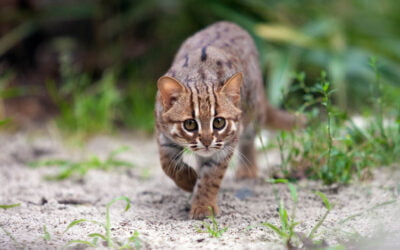Physical description of Marbled Cats
I guess nobody thinks that marbled cats are carved from stone, so the style of their coat should be relatively easy to deduce. The light brown color becomes quite marbled in the adult’s fur. The fur has more variable shading than the similar-looking clouded leopard. In comparison, the patches of color on the marbled cat are somewhat less defined and less regular than those of the clouded leopard. Marbled cats have white patches around their faces and ears.
Being about half a meter long makes them a mid-size cat. The tail length can also reach up to half a meter as well.
Distribution and habitat of Marbled Cats
The Marbled Cat lives in most of mainland Southeast Asia. They are found from India to Borneo but not everywhere and are relatively rare in mainland Malaysia. They are more common in Sabah in the Malaysian part of Borneo.
The marbled cat prefers a forested habitat, but they don’t seem to prefer one type of forest over another. We see that as they have been recorded in tropical forest, mixed forest areas and even logging areas with secondary growth. In some areas of their range, there are significant mountains, and the marbled cat has been spotted at up to 3000 m above sea level. It appears that marbled cats are even more widespread than we were previously aware of, as they are somewhat secretive and hard to spot given their arboreal lifestyle.
Marbled Cat behavior
Marbled cats are active all day and night, at least based on the limited observations of them that we have. It is hard to say whether or not this is truly indicative of their actual behavior. They are clearly expert climbers, and the size of their feet and legs suggest that they spend quite some time in trees.
One tracked female in 2001 showed a relatively small range, which was exclusively in a forest. It is always challenging to observe cats when they hide permanently in the forest cover. If you want to know more about marbled cats, you will have to go out and study these cats yourself. The few data points available don’t really tell us much.
Marbled cats have exceptional vision. Given their dark jungle home, they need to rely on good eyesight. The eyes are relatively large, and a flattened nose allows them to gather as much of the ambient light as possible. The vertical pupil, a feature of most cats, is more efficient at resolving features in low light features.
What do Marbled Cats eat?
Given the jungle lifestyle of the marbled cat, it isn’t easy to watch the cat hunt. Therefore, figuring out its dietary decisions isn’t easy. However, detective work can be pretty accurate, and we can be confident it preys on birds and small mammals. It seems that it preys on arboreal animals such as squirrels, small monkeys and bats. All meat sources are on the table, but it is probably birds that make up the majority of the cats’ diet.
Depending on where they live, this might vary, and the habitat has a big bearing on the food choices. While the cats are sometimes arboreal, at other times they are comfortable and successful on the ground.
Mating and Parental care of Marbled Cats
Despite modern technology and camera traps, sightings of marbled cats are still relatively rare. As such, we haven’t managed to discover a lot about their more secretive behaviors, such as mating. It isn’t because they are modest or shy, or that they are secretive, but rather because it is dangerous to engage in public mating behaviors when you aren’t the largest species in the jungle. Mothers of all cats are notoriously cagey about showing off their babies when they are born blind and barely able to walk.
What we do know about the biological properties of the reproductive cycle comes from captive animals. The information we do have doesn’t suggest anything different to most other cat species.
Who preys on Marbled Cats?
Coloring is crucial to the marbled cat, as it offers essential camouflage. Being shy and spending time in trees means it is not a target for most predators. We do not know for sure, but don’t think that any other animals prey on the marbled cat. However, the jungle doesn’t give up its secrets lightly.
Marbled Cats and their ecosystem
Similarly, we cannot be certain about the effect the marbled cat has on its ecosystem. However, a reasonable assumption is that it keeps its prey species in check like almost all predators.
Impact of Marbled Cats on the human economy
The marbled cat is so secretive and elusive that it doesn’t interact with humans, negatively or positively. Potentially, it might prey on poultry in very isolated settlements that encroach on their territories, but we do not have any data to confirm this.
Conservation status and human impact on Marbled Cats
The cat is not well protected – hunting is still permitted in Laos – and other countries don’t do anything specific to protect them, beyond hunting bans. As they are shy, it isn’t just habitat destruction that upsets them but also habitat change. Minor incursions into their territories by humans can have an outsize influence on their range. Therefore, the logging of large areas of Borneo is obviously a massive threat to the species.
Other important information about Marbled Cats
There are three subspecies Pardofelis marmorata marmorata, Pardofelis marmorata charltoni, and Pardofelis marmorata longicaudata.










